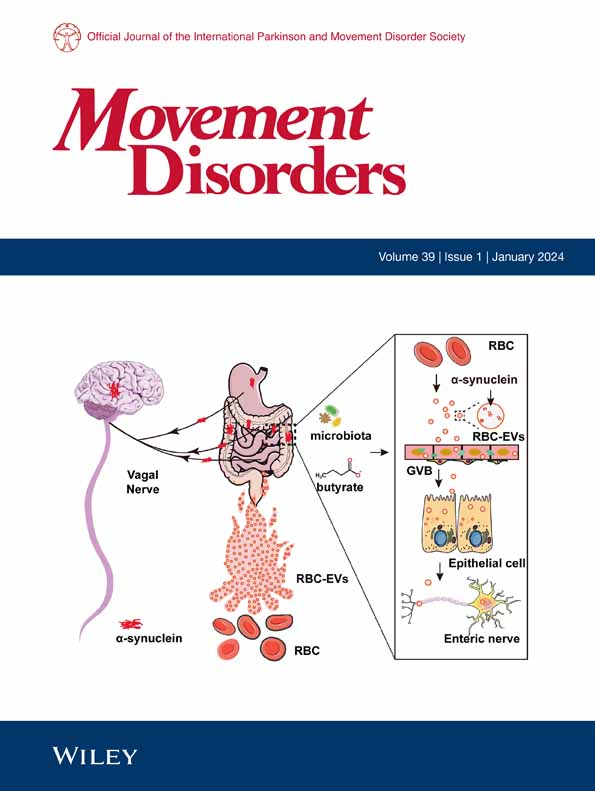求助PDF
{"title":"帕金森病患者眼下核的单侧磁共振引导聚焦超声病变:前瞻性研究","authors":"Laura Armengou-Garcia,Carlos A Sanchez-Catasus,Iciar Aviles-Olmos,Adolfo Jiménez-Huete,Genoveva Montoya-Murillo,Arantza Gorospe,Antonio Martin-Bastida,Lain Hermes Gonzalez-Quarante,Jorge Guridi,Maria C Rodriguez-Oroz","doi":"10.1002/mds.30020","DOIUrl":null,"url":null,"abstract":"BACKGROUND\r\nUnilateral subthalamic nucleus (STN) ablation using magnetic resonance-guided focused ultrasound (MRgFUS) is being explored as a new treatment for asymmetric Parkinson's disease (PD).\r\n\r\nOBJECTIVES\r\nThe aims were to study the efficacy and safety of this treatment in asymmetric PD patients and to characterize the lesions.\r\n\r\nMETHODS\r\nThis prospective, single-center, open-label study evaluated asymmetric PD patients at 6 (n = 20) and 12 months (n = 12) after MRgFUS lesion of the STN. The primary outcome was the change in the Movement Disorders Society-Unified Parkinson's Disease Rating Scale, Part III (MDS-UPDRS III), score in off medication on the treated side and the adverse events (AEs) at 6-month follow-up. We also evaluated cognitive-neuropsychological changes, self-assessment of clinical improvement, and the correlation of the lesion volume with the motor outcomes.\r\n\r\nRESULTS\r\nOn the treated side, the MDS-UPDRS III score (mean difference = 13.8) and the scores in rigidity, bradykinesia, and tremor improved (P < 0.001) throughout the follow-up compared to baseline (at 6 months: rigidity mean difference = 2.8, improvement: 83.5%; bradykinesia mean difference = 6.0, improvement: 69.4%; tremor mean difference = 4.7, improvement: 91.5%). One patient had severe weakness in the treated hemibody, 1 had moderate dyskinesia, and 1 was in moderate confusional state that became mild (weakness) or completely resolved (dyskinesia and confusional state) at 6 months. The rest of the AEs were mild. We observed no clinically relevant changes in cognitive-neuropsychological tests. The percentage of ablation of the STN correlated with the improvement in the total MDS-UPDRS III and contralateral tremor scores (P < 0.05).\r\n\r\nCONCLUSION\r\nUnilateral MRgFUS lesion of the STN resulted in a significant motor improvement. We observed no persistent severe AEs, although mild, mostly transient AEs were frequent. © 2024 The Author(s). Movement Disorders published by Wiley Periodicals LLC on behalf of International Parkinson and Movement Disorder Society.","PeriodicalId":213,"journal":{"name":"Movement Disorders","volume":"13 1","pages":""},"PeriodicalIF":7.4000,"publicationDate":"2024-09-18","publicationTypes":"Journal Article","fieldsOfStudy":null,"isOpenAccess":false,"openAccessPdf":"","citationCount":"0","resultStr":"{\"title\":\"Unilateral Magnetic Resonance-Guided Focused Ultrasound Lesion of the Subthalamic Nucleus in Parkinson's Disease: A Prospective Study.\",\"authors\":\"Laura Armengou-Garcia,Carlos A Sanchez-Catasus,Iciar Aviles-Olmos,Adolfo Jiménez-Huete,Genoveva Montoya-Murillo,Arantza Gorospe,Antonio Martin-Bastida,Lain Hermes Gonzalez-Quarante,Jorge Guridi,Maria C Rodriguez-Oroz\",\"doi\":\"10.1002/mds.30020\",\"DOIUrl\":null,\"url\":null,\"abstract\":\"BACKGROUND\\r\\nUnilateral subthalamic nucleus (STN) ablation using magnetic resonance-guided focused ultrasound (MRgFUS) is being explored as a new treatment for asymmetric Parkinson's disease (PD).\\r\\n\\r\\nOBJECTIVES\\r\\nThe aims were to study the efficacy and safety of this treatment in asymmetric PD patients and to characterize the lesions.\\r\\n\\r\\nMETHODS\\r\\nThis prospective, single-center, open-label study evaluated asymmetric PD patients at 6 (n = 20) and 12 months (n = 12) after MRgFUS lesion of the STN. The primary outcome was the change in the Movement Disorders Society-Unified Parkinson's Disease Rating Scale, Part III (MDS-UPDRS III), score in off medication on the treated side and the adverse events (AEs) at 6-month follow-up. We also evaluated cognitive-neuropsychological changes, self-assessment of clinical improvement, and the correlation of the lesion volume with the motor outcomes.\\r\\n\\r\\nRESULTS\\r\\nOn the treated side, the MDS-UPDRS III score (mean difference = 13.8) and the scores in rigidity, bradykinesia, and tremor improved (P < 0.001) throughout the follow-up compared to baseline (at 6 months: rigidity mean difference = 2.8, improvement: 83.5%; bradykinesia mean difference = 6.0, improvement: 69.4%; tremor mean difference = 4.7, improvement: 91.5%). One patient had severe weakness in the treated hemibody, 1 had moderate dyskinesia, and 1 was in moderate confusional state that became mild (weakness) or completely resolved (dyskinesia and confusional state) at 6 months. The rest of the AEs were mild. We observed no clinically relevant changes in cognitive-neuropsychological tests. The percentage of ablation of the STN correlated with the improvement in the total MDS-UPDRS III and contralateral tremor scores (P < 0.05).\\r\\n\\r\\nCONCLUSION\\r\\nUnilateral MRgFUS lesion of the STN resulted in a significant motor improvement. We observed no persistent severe AEs, although mild, mostly transient AEs were frequent. © 2024 The Author(s). Movement Disorders published by Wiley Periodicals LLC on behalf of International Parkinson and Movement Disorder Society.\",\"PeriodicalId\":213,\"journal\":{\"name\":\"Movement Disorders\",\"volume\":\"13 1\",\"pages\":\"\"},\"PeriodicalIF\":7.4000,\"publicationDate\":\"2024-09-18\",\"publicationTypes\":\"Journal Article\",\"fieldsOfStudy\":null,\"isOpenAccess\":false,\"openAccessPdf\":\"\",\"citationCount\":\"0\",\"resultStr\":null,\"platform\":\"Semanticscholar\",\"paperid\":null,\"PeriodicalName\":\"Movement Disorders\",\"FirstCategoryId\":\"3\",\"ListUrlMain\":\"https://doi.org/10.1002/mds.30020\",\"RegionNum\":1,\"RegionCategory\":\"医学\",\"ArticlePicture\":[],\"TitleCN\":null,\"AbstractTextCN\":null,\"PMCID\":null,\"EPubDate\":\"\",\"PubModel\":\"\",\"JCR\":\"Q1\",\"JCRName\":\"CLINICAL NEUROLOGY\",\"Score\":null,\"Total\":0}","platform":"Semanticscholar","paperid":null,"PeriodicalName":"Movement Disorders","FirstCategoryId":"3","ListUrlMain":"https://doi.org/10.1002/mds.30020","RegionNum":1,"RegionCategory":"医学","ArticlePicture":[],"TitleCN":null,"AbstractTextCN":null,"PMCID":null,"EPubDate":"","PubModel":"","JCR":"Q1","JCRName":"CLINICAL NEUROLOGY","Score":null,"Total":0}
引用次数: 0
引用
批量引用
Unilateral Magnetic Resonance-Guided Focused Ultrasound Lesion of the Subthalamic Nucleus in Parkinson's Disease: A Prospective Study.
BACKGROUND
Unilateral subthalamic nucleus (STN) ablation using magnetic resonance-guided focused ultrasound (MRgFUS) is being explored as a new treatment for asymmetric Parkinson's disease (PD).
OBJECTIVES
The aims were to study the efficacy and safety of this treatment in asymmetric PD patients and to characterize the lesions.
METHODS
This prospective, single-center, open-label study evaluated asymmetric PD patients at 6 (n = 20) and 12 months (n = 12) after MRgFUS lesion of the STN. The primary outcome was the change in the Movement Disorders Society-Unified Parkinson's Disease Rating Scale, Part III (MDS-UPDRS III), score in off medication on the treated side and the adverse events (AEs) at 6-month follow-up. We also evaluated cognitive-neuropsychological changes, self-assessment of clinical improvement, and the correlation of the lesion volume with the motor outcomes.
RESULTS
On the treated side, the MDS-UPDRS III score (mean difference = 13.8) and the scores in rigidity, bradykinesia, and tremor improved (P < 0.001) throughout the follow-up compared to baseline (at 6 months: rigidity mean difference = 2.8, improvement: 83.5%; bradykinesia mean difference = 6.0, improvement: 69.4%; tremor mean difference = 4.7, improvement: 91.5%). One patient had severe weakness in the treated hemibody, 1 had moderate dyskinesia, and 1 was in moderate confusional state that became mild (weakness) or completely resolved (dyskinesia and confusional state) at 6 months. The rest of the AEs were mild. We observed no clinically relevant changes in cognitive-neuropsychological tests. The percentage of ablation of the STN correlated with the improvement in the total MDS-UPDRS III and contralateral tremor scores (P < 0.05).
CONCLUSION
Unilateral MRgFUS lesion of the STN resulted in a significant motor improvement. We observed no persistent severe AEs, although mild, mostly transient AEs were frequent. © 2024 The Author(s). Movement Disorders published by Wiley Periodicals LLC on behalf of International Parkinson and Movement Disorder Society.


